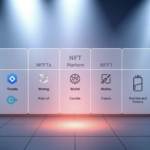Now Reading: Environmentally Friendly NFT Blockchains Carbon Neutral: A Greener Future
- 01
Environmentally Friendly NFT Blockchains Carbon Neutral: A Greener Future
Environmentally Friendly NFT Blockchains Carbon Neutral: A Greener Future

Digital ownership has evolved dramatically with the rise of unique tokens that verify authenticity and ownership. These tokens rely on decentralized networks to securely track transactions. However, older systems used methods that demanded vast computational power, leading to high electricity consumption.
Innovators are now prioritizing systems that balance efficiency with ecological responsibility. Newer networks adopt consensus models that require far less power while maintaining security. Some projects pair these advancements with initiatives to counterbalance emissions, creating a more balanced approach to digital innovation.
Critics have highlighted concerns about older platforms, emphasizing their strain on resources. Artists and businesses increasingly seek alternatives that align with modern sustainability goals. This shift not only addresses ecological worries but also opens doors for broader participation in the digital economy.
Key Takeaways
- Traditional token networks often use energy-heavy systems, raising ecological concerns.
- Modern solutions focus on efficient validation processes to reduce electricity use.
- Offset programs and renewable energy integration help mitigate ecological effects.
- Artists and investors can engage responsibly with newer, low-impact platforms.
- The shift toward sustainable practices supports long-term growth in digital markets.
Introduction to Eco-Friendly NFTs and Blockchain Sustainability
The digital collectibles space is undergoing a transformation. New solutions aim to merge innovation with planetary health, addressing concerns about resource-heavy systems. These advancements focus on redefining how digital ownership works while reducing strain on global ecosystems.

What Are Eco-Friendly NFTs?
These tokens prioritize efficiency without sacrificing security. Instead of relying on power-intensive methods, they use streamlined processes to validate transactions. Many leverage alternative consensus models that require minimal electricity, paired with programs to balance remaining emissions.
Creators now have options that align with modern ecological values. Collectors can support art and digital goods while knowing their participation supports responsible practices. This shift marks a critical step toward balancing tech growth with environmental stewardship.
Why Sustainability Matters in Digital Ownership
As demand for virtual items grows, so does their collective effect on energy grids. Older systems often consume as much power as small countries, raising alarms. Modern platforms prove that security and speed don’t require excessive resource use.
Businesses and artists increasingly choose low-impact alternatives to meet consumer expectations. This trend reflects a cultural shift toward valuing both innovation and accountability. By adopting these practices, the digital economy can expand responsibly.
Understanding the Environmental Impact of Traditional NFTs
Digital collectibles built on older systems face growing scrutiny due to their resource demands. Networks using Proof-of-Work (PoW) validation require staggering electricity inputs, often comparable to small nations’ annual usage. This raises urgent questions about scalability and long-term viability in a climate-conscious world.

High Energy Consumption in PoW Systems
Proof-of-Work blockchains like Ethereum demand intense computational work. Mining operations involve thousands of machines racing to solve complex puzzles, with only one successful validator per transaction block. The rest of the energy spent becomes redundant, creating massive inefficiency.
A single transaction on these networks can use more power than a typical home consumes in weeks. For perspective, Bitcoin’s annual energy use surpasses entire countries like Egypt. This winner-takes-all approach drives continuous hardware upgrades, accelerating electronic waste from outdated mining gear.
Carbon Emissions and Global Concerns
When mining relies on coal or natural gas, CO₂ output skyrockets. Regions with cheap fossil fuels dominate these operations, worsening the carbon footprint. Studies show Bitcoin alone generates over 70 million tons of emissions yearly – equal to 180 gas-fired power plants.
Critics argue such practices clash with global climate goals. Artists now face backlash for using high-energy platforms, while collectors seek alternatives. The push for change grows louder as renewable-powered solutions emerge.
Exploring “environmentally friendly NFT blockchains carbon neutral” Solutions
The tech industry is reimagining how digital assets operate to address ecological concerns. New systems prioritize efficiency while maintaining the security and transparency users expect. This shift represents a critical evolution in how networks verify transactions and manage digital ownership.

Defining the Green Transition in Blockchain Technology
Proof-of-Stake (PoS) has emerged as a game-changer, replacing energy-heavy mining with staking-based validation. Instead of solving complex puzzles, validators are chosen based on their existing holdings. This method slashes electricity use by over 99% compared to older systems.
The Role of Proof-of-Stake and Alternative Consensus Mechanisms
Platforms like Ethereum 2.0 use PoS to support digital collectibles with minimal resource demands. Alternatives like Solana’s Proof-of-History or Tezos’ Liquid Proof-of-Stake further optimize speed and efficiency. These models maintain decentralization while eliminating redundant computations.
Some networks pair these upgrades with carbon-neutral blockchain projects that offset remaining emissions through reforestation or renewable energy investments. This dual approach ensures creators can mint and trade tokens responsibly.
By adopting these solutions, the industry proves innovation and sustainability aren’t mutually exclusive. Artists gain tools to reduce their digital footprint while engaging global audiences. The result? A thriving ecosystem where technology serves both people and the planet.
Key Technologies Behind Sustainable NFT Platforms
Modern digital asset networks leverage groundbreaking technologies to minimize ecological footprints while maintaining robust performance. These systems combine innovative validation methods with optimized transaction processing, proving that speed and security don’t require excessive resource consumption.

Energy-Efficient Blockchains Like Ethereum 2.0, Tezos, Solana, and More
Ethereum 2.0 leads the charge with its Proof-of-Stake upgrade, cutting network energy use by 99.95%. This shift maintains compatibility with existing digital assets while enabling faster transactions. Artists can mint items without guilt, knowing each action uses minimal electricity.
Tezos stands out with self-upgrading features that eliminate hard forks. Its liquid Proof-of-Stake model requires validators to stake tokens rather than solve puzzles. This approach keeps energy demands low enough to power small offices instead of cities.
Solana pairs Proof-of-Stake with Proof-of-History timestamps. This combo processes thousands of transactions per second using energy comparable to basic web searches. Flow blockchain takes a different route, separating network roles to streamline operations for digital collectibles.
Smart Contract Innovations for Reduced Energy Use
Developers now optimize code to slash computational demands. Batch processing lets creators mint multiple items in single transactions, reducing fees and energy waste. Lazy minting delays resource use until items sell, preventing unnecessary calculations.
Gas optimization techniques trim excess data from contracts. These tweaks make interactions faster and leaner. Combined with renewable-powered networks, these advancements redefine what’s possible in digital ownership.
These platforms show how smart engineering balances innovation with responsibility. They provide artists tools to thrive while keeping ecosystems intact – a blueprint for tech’s greener future.
Strategies to Reduce Carbon Footprint in NFT Transactions
The push for sustainable digital transactions has sparked innovative approaches to minimize ecological impacts. Platforms now combine technical upgrades with ecological accountability, creating pathways for users to participate responsibly. These methods ensure digital markets grow without compromising planetary health.
Carbon Offsetting and Renewable Energy Initiatives
Projects now calculate emissions from minting and trading, then invest in verified programs to balance outputs. Reforestation partnerships absorb CO₂, while solar or wind energy powers validation nodes. Real-time tracking tools let users see their impact and buy credits automatically, aligning actions with global climate goals.
Wind farms and geothermal plants are replacing coal-dependent mining hubs. For example, some networks use hydroelectric dams to run servers 24/7. These strategies for reducing environmental impact cut fossil fuel reliance while maintaining transaction speeds.
Sustainable Smart Contract Design
Developers optimize code to slash energy demands. Batch processing groups multiple actions into single transactions, reducing computational waste. Lazy minting delays resource use until items sell, preventing unnecessary calculations.
Efficient algorithms trim data loads without sacrificing security. These tweaks make interactions faster and leaner. Combined with renewable-powered networks, such practices prove innovation can coexist with responsibility.
Selecting the Right Blockchain for Sustainable NFT Development
Choosing the best platform for digital collectibles demands careful evaluation of technical and ecological factors. While many networks claim efficiency, their real-world impact depends on node locations, energy sources, and upgrade commitments.
Comparing Blockchains: Energy Consumption and Environmental Impact
Geographic node distribution plays a critical role. Ethereum operates 2,900 U.S. nodes where 79% of electricity comes from fossil fuels. However, its Proof-of-Stake system slashed energy use by 99.95%, making it viable despite local grid limitations.
Key considerations when selecting platforms:
- Consensus models: PoS networks like Solana use 1000x less energy per transaction than older PoW systems
- Renewable partnerships: Algorand offsets emissions through carbon-negative contracts
- Scalability: Tezos handles growing transaction volumes without proportionally increasing resource demands
Cardano stands out with peer-reviewed upgrades ensuring long-term efficiency. Developers also prioritize transaction throughput, as faster processing reduces per-action energy costs. Always verify if networks use lazy minting or batch transactions to minimize waste.
While no system is perfect, these metrics help creators balance innovation with responsibility. The right choice supports both artistic vision and planetary health.
Innovative Carbon Offsetting and Renewable Energy Solutions for NFTs
The next frontier in sustainable digital innovation combines clean power with measurable climate action. Platforms now integrate energy sources like solar and wind to power operations while supporting programs that counteract ecological impacts. These dual strategies ensure every transaction contributes to a healthier planet.
Utilizing Renewable Energy for Network Operations
Solar farms and wind turbines increasingly power validation nodes, replacing fossil fuel-dependent grids. Hydroelectric dams provide 24/7 energy for servers in regions like the Pacific Northwest. Geothermal plants near volcanic zones offer another low-impact option, cutting reliance on coal and gas.
Projects and Practices to Offset Emissions
Platforms partner with reforestation initiatives that absorb CO₂ equivalent to network outputs. Tools like Aerial track digital footprints, letting users invest in verified offset projects. Through blockchain-powered offset platforms, creators automatically balance emissions via carbon capture technologies.
These solutions prove tech progress can coexist with planetary care. By prioritizing renewables and accountability, the industry builds trust while pushing boundaries.












